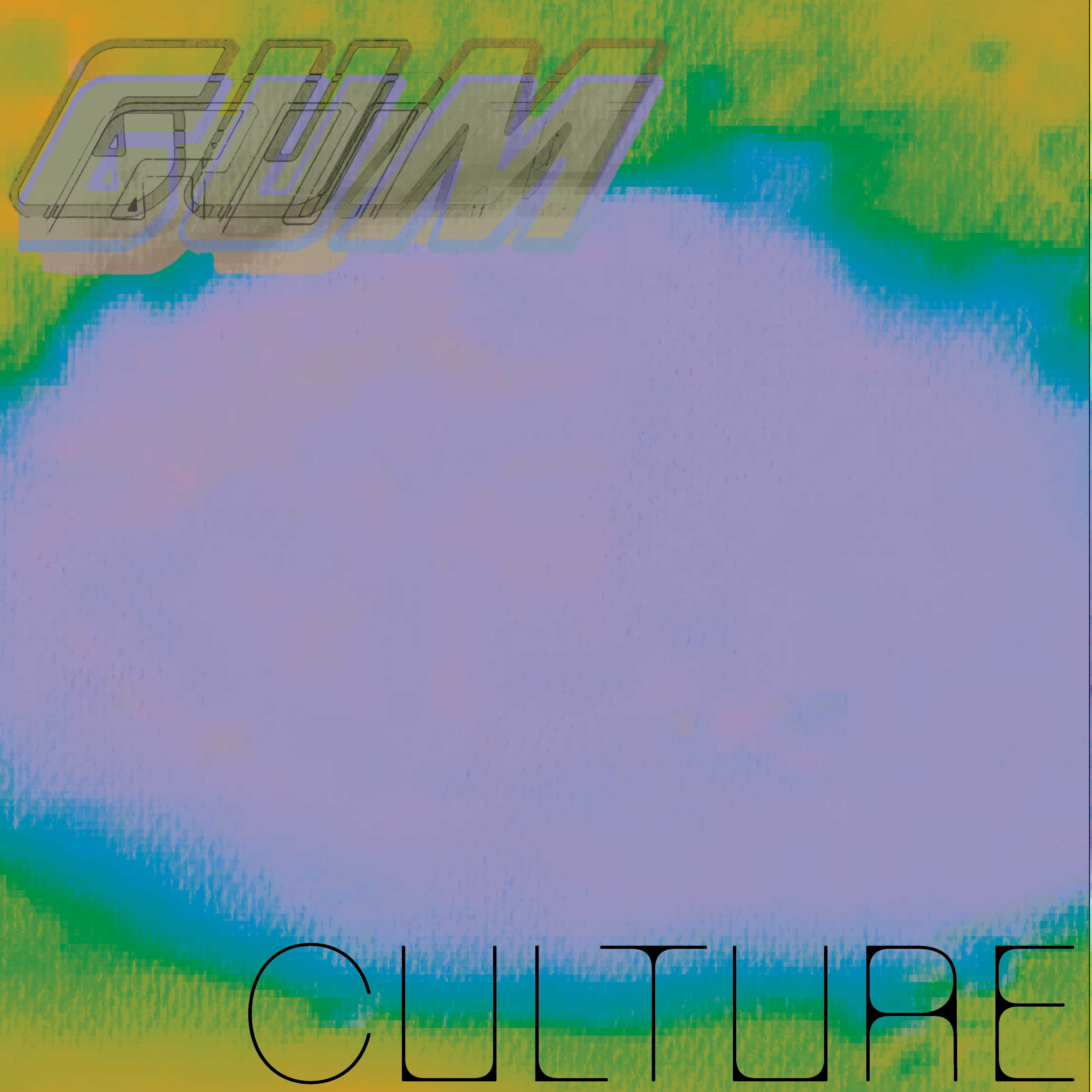Words: Amelia Morek (she/her)
‘Learn to embrace your newfound sexy androgyny. Maybe everyone should embrace their sexy androgyny. I think that is the ultimate message of our show.’
The unsuppressed expression of gender and physicality is deeply rooted in Nicole O’Reilly’s and Luke ‘Luca’ Cockayne’s installation art show Phreaking Gender, a direct rebellion against customary boundaries. The exhibition is striking not only on a substantive level but even in its technical aspects, with a notable fusion of different forms of expression. Nicole explains: ‘It was always planned to showcase our strengths individually as artists that would fit into the themes of “hacking gender” in this punk DIY sorta way.’
Both artists stressed the importance of collaboration and open critical discussions that allowed them to merge approaches. ‘It can be chaotic and hectic because one of us will be like ‘I love the colours in that, let me expand it into a painting’ or ‘that line could be a voiceover for this piece of footage,’ Luca adds.
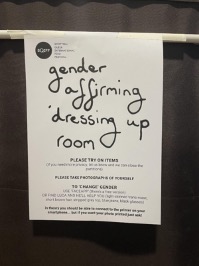
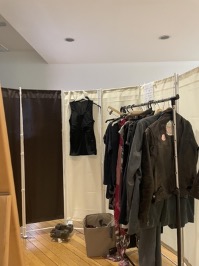
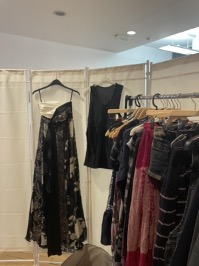
This dialogue is noticeable in the exhibition. All the pieces seem freed from the limitations of boxes, with both artists happily swinging between various techniques and playing with set notions about the passive relation between the artwork and its audience. Most obviously, by including a gender-affirming dressing-up room and “How I Wish I Looked.” Nicole says that ‘by having interactive elements in our show, we allow even cis-straight people to play around with the shape of themselves and experience freedom within a safe environment. Gender-fuckery shouldn’t be limited to trans people: we need to liberate all of society from arbitrary restrictions placed on us.’
The spectator is encouraged to take photos and digitally manipulate them, before attaching them to the wall that is collectively filled out by the visitors. Luca wanted to play with continuous curation, adding: ‘The exhibition is never “done” but constantly evolves in response to the audience.’
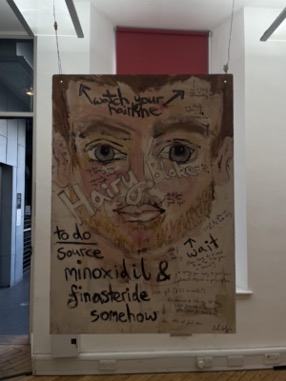
Blurring the border between the art/artist and its audience is a common theme across the exhibition. For example, The Way I Wish My Voice Sound puts the spectator in a comfy armchair listening to the narrator’s confessions. Luca admits that he wanted to achieve ‘the effect of listening to a friend or the thoughts in your head. The speaker was at shoulder level, to encourage this feeling of intimacy.’
Hairy Bloke is another prime example of that. The heavy incorporation of the written text brings a beautiful stream-of-consciousness feel to the artwork. Arrows and text that meticulously explore facial details make the subject defenseless, thus closer to its viewer. Luca clarifies he uses Teeline shorthand and abstract painting techniques to obscure the literal meanings of much of his work, reflecting the tension between needing to discuss trauma and how much we are actually willing to share.
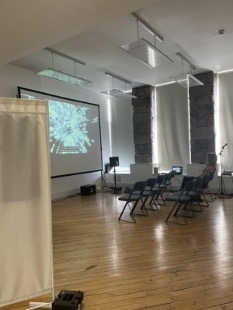
Nicole’s work intertwines a parallel exploration of the need for shared intimacy in art and the boundaries it entails, delving into the intricacies of relationships and opening up to others. Her documentary Phreaking Gender showcases trans stories, mainly focusing on hormonal treatment outside the official healthcare system. The film doesn’t shy away from bold, close-up physicality while immersing the viewer in a domestic setting and personal narrations. Nicole admits: ‘It surprised me what people were willing to put out there. The main approach I took was asking people if they’d like to show them doing DIY hormones or whatever gender-affirming stuff they felt comfortable with on camera and then talking about the boundaries of it. There’s something empowering about allowing ourselves to be vulnerable through art. Showing nude bodies that are queer and different, marginalised and disabled when we’re either portrayed in highly fetishized ways or as objects of ridicule, is a radical act.’
This thought ties in beautifully with Luca’s past work, especially his graduation film, showcasing a sex act that caused controversy at the time. Luca shares: ‘It’s been… challenging living with the consequences. The Daily Mail article used to come up in almost every professional interview, in Dundee people would tell me about it not knowing it was my work. I got interviewed about it for someone’s undergraduate dissertation a couple of years ago. It was only when I started transitioning and changed my name that I stopped being so directly associated with it. It’s hard to navigate a career in something public like the arts when you’ve had early coverage like that.’
The film is revisited ten years later with an embracing twist. Luca reclaims the narrative by glitching the footage and adding in comments the public made. Art or Pornography is a remarkably self-aware artwork, captivating in its meta-exploration of the author’s creative and personal journeys. Luca explains: ‘Re-editing the footage and adding to it and thinking about what’s changed and what hasn’t in my life and society in those ten years… it’s been valuable for me as an artist and as a person. What connects me to the work is the question: how do we curate difficult work, without re-traumatising the artist or harming the viewer? When you create work that involves nudity or sexuality you have to make a decision whether to warn people and then how to warn them. You have to consider your legal and moral obligations, what can be seen from outside the gallery space, how far sound is carrying, etc. I think considering those things is important for anyone sharing their work: it makes you a better artist to consider the audience in that way. It’s easy to get it wrong, but when you get close to getting it right you can feel a difference.’
The many layers of intertextual context and the solicitude with which it addresses ethical curatorial dilemmas, while remaining light-hearted, are the very reasons Art or Pornography is my favourite from the exhibition. Yet picking “favourites” doesn’t apply to Phreaking Gender. Every piece is equally essential in capturing fluidity and interconnectedness. It doesn’t function as 14 separate works but rather as 1 whole experience. A Transgender Experience ™ freed from society or art’s rules of expression.
Huge thank you to Nicole O’Reilly and Luca Cockayne for their art and their participation in the interview.
Picture credits: Amelia Morek and Stewart Campbell

